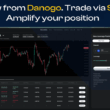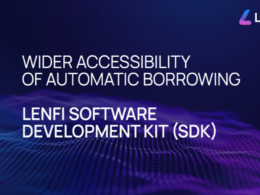This article is the first of a two-part series that seeks to explain how leveraged trading works on the Cardano blockchain. In this piece, we’ll introduce leveraged trading in DeFi, explain how it works, and differentiate it from its counterpart in the traditional markets. We’ll also expound on the Danogo flexible lending pool, which forms the base of leveraged trading on Cardano.
All DeFi protocols observed. Crypto newbies and seasoned Web3 builders, we converge here today to discuss leveraged trading on Cardano, a subject worthy of your time. In fact, it’s relatable that there aren’t many folks knowledgeable, if not seeking to be, in matters of crypto like you. This article assumes prior trading knowledge and builds on that awareness in the DeFi realm.
Our good innovations, namely, blockchain technology and cryptocurrencies, have played a huge role in expanding investment strategies. This is true for investors at both retail and entrepreneurial levels. If we narrow it down to decentralized finance (DeFi), then new opportunities are on the ever-rising trajectory. On Cardano, leveraged trading in DeFi is steadily gaining ground. While platforms like Danogo lead the way in providing these services, others are pivoting to offer token metrics in support.
As DeFi leveraged trading continues to flourish, it is important to note that it seeks to amplify earnings by borrowing funds from liquidity pools. It is renowned for its higher profit potential, trading portfolio efficiency, and opportunities in bear markets. The same factors that make it attractive also pose a risk, and this is the core rationale behind this article series: to educate you on how to trade leverage on Cardano.
What is Leveraged Trading in DeFi and How Does it Work?
The simplest definition describes DeFi leveraged trading as borrowing funds from an exchange to increase the size of your market position, thereby controlling much more capital during trades than is in your initial investment. Of note is that borrowed capital is provided by other users or a liquidity pool in the DeFi ecosystem, and different platforms will offer diverse leverage ratios. An example will put this into perspective.
John is a crypto trader with $500 at his disposal. If he uses 10x crypto leverage, he is dealing $5,000, and a 10% increase in his asset’s price translates to $500 in profits, or 100% worth of his capital. If the price drops by 10% his position is wiped out completely. This begs the question: So, how does leverage work in crypto? How does it differ from traditional markets?
How Leveraged Trading Differs from the Traditional Market
We suspect that in this context, you’re largely, if not exclusively, aware of leveraged trading in traditional markets (stocks and forex). Now, the underlying concept of borrowing to amplify is the same, but there are subtle differences, all stemming from the debut of decentralization. The conflicting factors are custody and control, source of leverage, transparency, collateral management, market hours, execution speed, interest and fees, risk types, flexibility, and innovation.
Where traditional markets have ownership in the hands of brokers, crypto is all about self-custody wallets. Where loan terms are opaque, transparency is the norm in Web3. In traditional markets, collateral requirements are set by brokers and regulators, but in crypto, over-collateralization is common to protect lenders and is enforced through smart contracts. Trading hours are limited, while in crypto, you have 24/7 price movement, which is more flexible. Brokers have a notable latency in trades, whereas DeFi trades are instant on smart contracts. In traditional markets, innovation progressed slowly, but DeFi protocols are highly composable, meaning they integrate with other earning strategies such as yield staking, farming, and even NFTs.
The need for leveraged trading in DeFi stems from several reasons. If you have limited capital, even with the right trades, your earnings have a limit, so leverage gives you an edge. Expert traders opt for leveraged trading because their strong conviction enables greater profits. We need not dwell on the limitations of traditional markets, as we have observed, portfolio diversification in Web3 serves as a safety net. Non-trader investors have found liquidity provision to be more rewarding than traditional yield farming. The drawbacks we reserve for discussion under risks and considerations.
Understanding Danogo’s Flexible Lending Pool
A lending pool is just one part of the Cardano DeFi landscape, which is all about using ADA or any other supported token (as collateral) to receive a loan. If you aren’t taking a loan, your assets provide liquidity to the pool (assets that others can borrow), and in turn, you earn some income passively. Each lending protocol will have its own lending rates based on assets, time, supply vs demand, and other protocol-specific factors. In practice, every lending protocol issues its token as a representation of your investment. Danogo issues a dToken — much can be learned from Cardano Forum’s discussion of staking vs lending pools.
Native to the Danogo protocol is the architecture of compound financial services, where you earn interest on your supplied assets or can still borrow against them. However, unlike other static DeFi lending pools, Danogo is flexible, with platform-specific adaptations that collaboratively deliver a sleek financial experience through unique models. We’ll expound on these features for clarity.
Key Features of Danogo’s Flexible Lending Pool
One, Danogo asset prices are derived from aggregating multiple independent oracles (such as Indigo, Orcfax, and other DEXes) to improve reliability and resistance to manipulation. Besides mitigating the risk of centralization by relying on a single oracle, the prices are derived from consensus-based aggregation. Two, Danogo allows programmable loans. Such is the case where other DApps or smart contracts programmatically initiate, run, and close loans on-chain. Leveraged trading, automated strategies, and flash loans depend on this core.
Other important design specifications worth mention are continuous compounding, parallel liquidation threads, automatic staking reward distribution, and composability. In other protocols, interests are awarded as batch transactions at discrete time intervals, but Danogo supports real-time accumulation of yields for suppliers and debtors alike, a precise, fair experience. During market crashes, other protocols experience liquidation backlogs that compromise protocol reliability, but Danogo allows multiple liquidations to occur simultaneously to preserve protocol integrity and enable rapid action in response to volatility.
For ADA providers, staking rewards are allocated at the end of each epoch, increasing the dToken value, and, as a protective measure, prevent users from withdrawing before an epoch ends to supply at the beginning of another and receive double rewards. Users providing ADA as collateral retain their voting rights and can delegate to their DRep of choice in accordance with governance incentives.
Composability and Capital Efficiency in Danogo
Danogo’s flexible lending pool is composable, enabling it to integrate with other yield-generating protocols to maximize capital efficiency when funds are idle. In simpler terms, when Danogo’s lending pool holds unused liquidity, it is supplied to other lending protocols. To avoid compromising its core operations, Danogo’s flexible lending pool can withdraw external supplies or even deny allocations to match internal borrowing demands. As a benefit, this dynamic ensures protocol sustainability in addition to additional yields. Here’s a detailed guide on Danogo’s flexible lending pool.
Next Steps: A Practical Walkthrough of Leveraged Trading on Danogo
In this article, we introduced leveraged trading on the Cardano DeFi space. We explained how it works and tabled its differences from the Traditional markets. We have also discussed the Danogo Flexible Lending pool, which forms the baseline upon which leveraged trading is built on. In the next piece, we talk about Danogo’s Integration with Splash and how this dual powers leveraged trading on Cardano.










